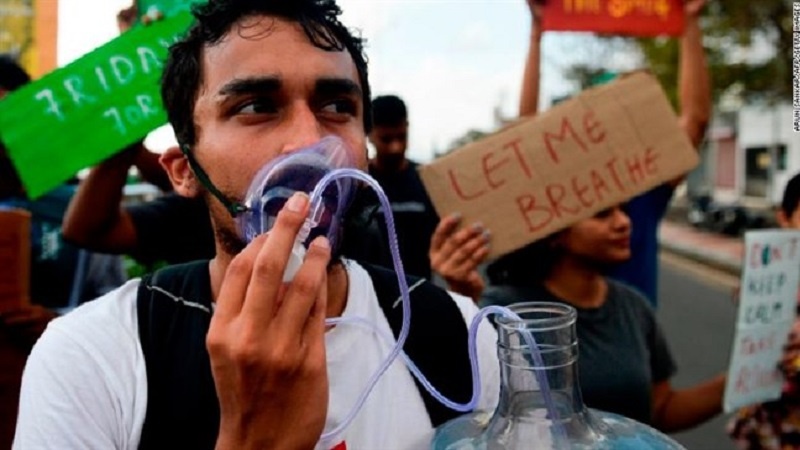In Asia Pacific climate crisis is happening now, not in future
Many big Asian cities, including Mumbai, Shanghai, Bangkok, and Jakarta, are coastal and low-lying, making them susceptible to sea level rise and other extreme weather events.
Fast-growing, industrializing and coal-reliant Asian countries are pumping out increasing levels of carbon dioxide emissions, despite efforts by nations such as India and China to move towards cleaner energy. While wealthier cities like Hong Kong can afford to disaster-proof — to an extent, at the other end of the scale, poverty-stricken populations are living in some of the most environmentally precarious places on Earth, where extreme weather events could prove disastrous for lives, food production, water sources, economies and infrastructure.
The following is an article concerning this issue written by ‘Helen Regan’ under the heading: “In Asia Pacific climate crisis is happening now, not in future.” The article was taken from the Koamnewsnow.com.
The world’s most disaster-prone region felt the harsh reality of the climate crisis in 2019. Toxic smog shrouded Asian megacities, hundreds died in flooding and landslides, cyclones battered coastlines and bushfires, droughts and deadly heatwaves led to towns and cities almost running out of water.
Far from being anomalies, scientists say the climate crisis is causing more extreme weather events — and it’s having devastating consequences in Asia and the Pacific.
A United Nations’ Economic and Social Commission for Asia and the Pacific (ESCAP) report in August said the “relentless sequence of natural disasters” over the past two years “was beyond what the region had previously experienced or was able to predict,” adding, “This is a sign of things to come in the new climate reality.”
Rallying calls for climate action have been made in countless forums, summits and pledges this year. But while many people in developed countries see the climate crisis as an urgent but future problem, for millions living in Asia-Pacific, it’s already touching every part of life.
Those on the front lines say words must now translate into tangible change as the world heads into a new decade. The Asia-Pacific region, home to 60 percent of the world’s population, is one of the most vulnerable areas to the climate crisis.
Compounding the problem is rapid urbanization in many Asian nations, with the pace of development often overtaking proper infrastructure planning. Population booms and the mass migration of people to cities for work is putting strain on water and food supplies.
Many big Asian cities, including Mumbai, Shanghai, Bangkok, Ho Chi Minh City, and Jakarta, are coastal and low-lying, making them susceptible to sea level rise and other extreme weather events.
Fast-growing, industrializing and coal-reliant Asian countries are pumping out increasing levels of carbon dioxide emissions, despite efforts by nations such as India and China to move towards cleaner energy.
As material wealth grows, so too does the consumer market and demand for emissions-producing conveniences such as air-conditioning, cars and disposable goods.
While wealthier cities like Hong Kong can afford to disaster-proof — to an extent, at the other end of the scale, poverty-stricken populations are living in some of the most environmentally precarious places on Earth, where extreme weather events could prove disastrous for lives, food production, water sources, economies and infrastructure.
World Meteorological Organization Secretary General Petteri Taalas, in a statement said “If we do not take urgent climate action now, then we are heading for a temperature increase of more than 3°C by the end of the century, with ever more harmful impacts on human wellbeing,” adding,
“We are nowhere near on track to meet the Paris Agreement target.”
As a resident of the low-lying Pacific Island of Samoa, Tagaloa Cooper-Halo has experienced climate changes first hand.
Cooper-Halo, who is Director of Climate Change Resilience at the Secretariat of the Pacific Regional Environment Programme (SPREP) said “Sea level rise is speeding up,” adding, “We expected sea level rise in about 20 years to be showing the changes. But we are seeing it already now.”
In a landmark report this year, the United Nations’ Intergovernmental Panel on Climate Change (IPCC) confirmed that global sea levels are rising faster than expected.
A study released recently found increasing greenhouse gas emissions, warming temperatures, melting glaciers and disappearing ice sheets could cause sea levels to rise more than two meters (6.6 feet) by the end of this century if emissions continue unchecked.
A rise of two meters would displace 187 million people, mostly from Asia, and swamp major cities such as Shanghai. Another study suggested that in Southeast Asia, parts of southern Vietnam and Bangkok could be underwater by 2050.
According to the UN Development Program, adapting to rising sea levels will be a key challenge for Asia-Pacific. Measures include defending coastlines and infrastructure, restoring mangroves, and identifying areas at risk from flooding.
Cooper-Halo said Pacific nations have already been forced to adapt, installing monitoring stations that measure sea level rise and growing crops more resilient to saltwater.
She said diets have already changed as ocean acidification and coral bleaching have reduced fish stocks.
Cooper-Halo said “When resources are not as plentiful as they used to be, it changes your dependency, you become more dependent on processed food and therefore we have to import a lot of processed food so it changes the way that we eat, and it therefore affects our health.”
About 2.4 billion people — about half the population of Asia — live in areas
vulnerable to extreme weather events. This year, flooding and landslides, triggered by torrential monsoon rains, swept across India, Nepal, Pakistan, and Bangladesh, leaving devastation in each country and hundreds of deaths.
China, Vietnam, Japan, India, Bangladesh, South Korea, Thailand, Sri Lanka and the Philippines, were all hit by tropical storms and typhoons — or cyclones — in 2019, causing dozens of deaths, hundreds of thousands displaced and millions of dollars in damage.
The climate crisis is expected to create higher storm surges, increased rainfall and stronger winds. According to the World Meteorological Organization, seven out of 10 disasters that caused the biggest economic losses in the world from 1970 to 2019 are tropical cyclones.
The high economic cost of typhoons can cripple poor countries. All cities vulnerable to typhoons are under pressure to improve infrastructure and properly plan for future growth. Investing in early warning systems has already saved countless lives.
Preparing for more extreme weather costs money and there are calls for rich nations to provide smaller economies with finance and technology to recover from the impacts of the climate crisis.
ME



